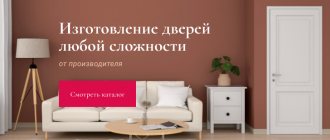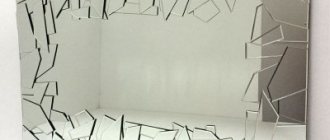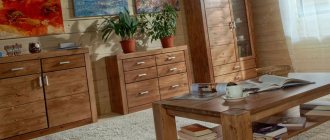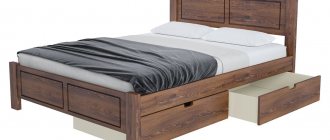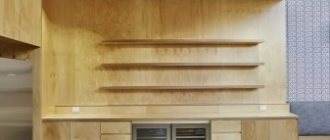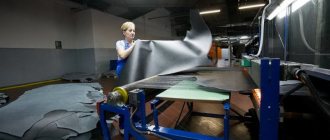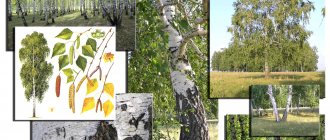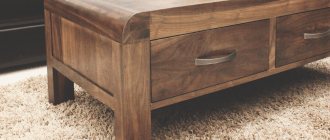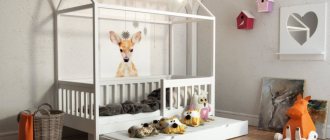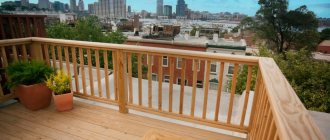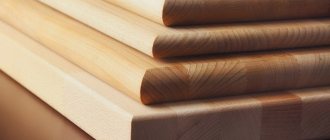Birch is a symbol of our country and there is an explanation for this. Huge forests and tracts of birch groves can be seen in Russia. From time immemorial it was used as lumber, but other times came and this wood appeared before us in a completely different form. Children's bed-sofa made of birch
Today, in carpentry, birch is given special attention. People have learned to work with this material and the scope of use of birch has increased many times over.
For example, in the production of home furniture, birch is a leader among other species. Firstly, its price is much lower than valuable oak or ash, and its average characteristics allow it to be used even in the manufacture of interfloor stairs to residential buildings. Once upon a time, it was only firewood and building material. Now, when ordering a staircase for a home in Barnaul, 80% of manufacturers offer exactly this. However, birch cannot be used in a room with high humidity or a possible change in humidity. Drying birch is unique and does not forgive haste. The use of birch products in damp rooms is extremely undesirable, as it absorbs excess moisture. These disadvantages are far from a death sentence for birch if you understand how many advantages there are. It lends itself perfectly to various types of processing, both manual and mechanized. As a result of planing and milling, a clean surface remains with virtually no chips. If the carpenter has certain skills, the quality of the product can compete with any Italian brand. The flaws are reduced to zero!
Birch furniture panel
Buying dry birch in Barnaul will not be difficult. The quality of dry boards varies by grade, hence the price.
In large construction stores, such as Leroy, you can buy, for example, a ready-made staircase to the basement or to the country house. In general, where our requirements for the product are not high. Steps and other components purchased in the store are made without waste; they are spliced from various pieces of wood and resemble parquet. The Papa Carlo company does not use such technologies. Why? Yes, because the use of pieces of wood glued together at the end, for example for steps, violates all the rules and regulations of carpentry. But marketers don’t eat their bread for nothing. Considering the fact that birch needs longitudinal sawing in order to relieve the tension of the fibers, they claim that end-joined panels are better than glued solid lamella panels. Actually this is not true. If you need building material to make a staircase to your dacha, then furniture board is quite suitable for this. You just can’t count it as an array. Joinery material is more expensive than construction material, and for high quality, joinery workshops in Barnaul overpay up to 30% of the cost. 22,000 rubles is the real price for the so-called zero grade of one cube of birch.
Features of wood
Birch grows quickly, adapts easily, and recovers well. Its wood is easy to process and polishes well.
Birch is made from:
- parquet,
- skis,
- plywood,
- products for turning production,
- furniture.
Wood is not subject to rot, which is why birch bark letters were found, as well as tues, boxes, and boats. Each of these products is over 500 years old. The Slavs believed that birch saved from troubles and ensured well-being. Therefore, she was always planted next to housing. In modern farming, using birch is quite expensive, although its technical and mechanical characteristics are quite high.
What is better for making stairs, birch or larch?
Papa Carlo company specialists constantly analyze search queries, where they often ask what is better for making stairs, larch or birch? Larch is undoubtedly very moisture resistant, this is its main quality. Only in home conditions with stable temperature and humidity this merit is not noticeable; on the contrary, the material is not used for its intended purpose. No, no one argues, larch stairs are good, they just perform better in damp basements with constantly high humidity.
Let me give you a simple example. Two neighbors built fences, one of pine and the other of larch, as a warning to the first. So, in rainy and sunny conditions, the pine stood longer, and the larch fell down. The example is not entirely related to the topic of stairs, but I want to say that the main quality must be used for its intended purpose. That is why in Venice, or whatever, in St. Petersburg they would have thrown hats at me. There, larch works at 100% efficiency. Therefore, in conditions where there is plenty of birch, the answer is clear. It is better to make stairs for your home from birch.
General properties and characteristics
A birch tree must grow for about 70 years in order to become a raw material for the wood processing industry. Its wood makes a pleasant impression: light, milky white, with an admixture of yellow and pink flowers. The severity of tree rings is assessed as weak.
According to the international standard DIN 4076, birch is designated by the abbreviation “BI”.
After atmospheric drying, at a material moisture content of about 12%, its density is approximately 650 kg/m?. This indicator corresponds to the average value between medium-heavy and heavy types of wood. Birch material is quite soft, for this reason it is sometimes classified as a soft-leaved species, prominent representatives of which are poplar and linden. This is not entirely true. It is more correct to consider birch as a material of medium hardness. In addition, birch wood has high elasticity and toughness, it is difficult to split and is characterized by an average bending strength.
Birch trees belong to the non-core species: sapwood and heartwood are very similar in appearance, have the same color, from yellowish-beige to pinkish, reddish spots may occur. There is a silky shine.
Sometimes the age of a tree can be determined by its color: in older specimens, the kernels have a reddish or brown tint. Birch wood fibers are rare, sizes vary from small to medium, and the pores are scattered.
One of the most valuable properties of birch is its unpretentiousness; it grows in almost any conditions. It is important that the growth process occurs quite quickly.
Birch wood is easily subject to rotting, so if the finished product is planned to come into contact with water, treatment with antiseptics is considered mandatory.
Features of downy, silver and dwarf birch wood
In Central Europe, the most common species are silver birch and downy birch.
- Downy birch, unlike silver birch, is heavier, more viscous and has relatively thin fibers;
- Silver birch has a twisted wood structure, which creates a beautiful play of light and color. Crossing or propagation allows this characteristic to be reproduced in subsequent generations of trees.
Dwarf birch grows short, its industrial value is low due to the small size of the tree itself.
Which is better, birch or ash?
If you compare these two completely different materials, the only advantage of birch becomes obvious: the price.
No, birch is an excellent material, but you can’t compare it with ash. The philosophy of these species is completely different; it is more correct to compare it with oak. Birch is smooth, and ash is textured with a rich grain pattern. Birch is well tinted into noble colors, but in the case of ash, a patina can be applied to the pores, but this will not work with birch. If you want to order white furniture made of wood, then you should know that the birch will be completely painted over, and the ash will retain its beautiful pattern and will definitely win in tactile perception. BIRCH
_____________________________
ASH
Beech or birch stairs?
Beech in its essence is very similar to birch, but has greater hardness. However, both breeds dislike moisture and beech to a greater extent. The price of beech is higher, so in equal conditions, I would choose birch. More precisely, that's what I did. In my house there is a birch staircase to the second floor.
Pine or birch?
To make stairs, it is better not to use soft pine, but to choose harder birch. In the manufacture of furniture, this is a controversial issue, because birch furniture is more expensive, and economy class furniture is usually made from pine. Birch is not used in the manufacture of interior and entrance doors. The exception is the combination of birch with moisture-resistant birch furniture board. Birch is not used in the production of outdoor furniture due to its hygroscopicity, and pine is often brushed, thereby increasing its service life.
Types of birch wood
Thus, today there are more than 40 species of birch, each of which has its own value. For example, silver birch is less durable, and therefore it is not suitable for the construction of houses from laminated veneer lumber and other buildings. On the contrary, iron birch is distinguished by its strength and durability, but developers do not always undertake to build structures from it. However, in the furniture industry, almost all varieties of birch are popular, since this species is quite simple and pleasant to work with.
Application of birch
Wood is used in various fields of industry; construction and finishing materials are made from it: plywood, veneer, building parts, fittings, parquet boards, etc. In the chemical industry, furfural is produced from birch sawdust.
And carpentry products are highly valued, carved souvenirs and toys, dishes. Skis are also made. The density of birch allows it not to crack for a long time, so masters of artistic cutting use it for crafts and other products (boxes, cigarette cases, etc.).
Wood is not suitable for construction, as it rots quickly, but it is suitable as a finishing for interior surfaces.
For large products, large old trees aged 60-100 years are most often used. For making firewood (birch is excellent for heating), trunks that are 40-60 years old are suitable.
An amazing material is the so-called iron birch, which grows in Primorye and was first discovered by the botanist Schmidt. The tree lives up to 200 years of age and has amazing properties. It was used to make ship hulls that were resistant to rotting, corrosion, and were not destroyed even when exposed to acids. A bullet does not pierce an iron birch board, and it is 3.5 times stronger in bending than cast iron.
Standards according to GOST and special types of birch wood
Standard standardization determines not only the optimal values of hardness, density, moisture content, as well as color and size, but also determines the number of possible defects and where this wood can be used.
So:
- GOST 862.3-86 indicates that for, for example, skis, grade 1 birch should be used, the thickness of the workpiece does not exceed 16 centimeters and the length is 1.5 meters.
- GOST 9462-88 states that birch wood of grades 1 and 2 with a nominal minimum length of 1.3 meters should not have wormholes, sapwood rot and the height of branches from the bark at the level of 2 centimeters can be used for the production of plywood;
- GOST 2292 specifies standards for the safe transportation of wood, including birch;
- GOST 9014.0 (one of 4) determines the standards for wood storage.
Quality standards also set the amount of use of substances that increase the performance characteristics of wood.
Stabilized
Polymerized birch wood or stabilized birch wood is impregnated with fillers and can be used in the manufacture of knife handles, ax handles, and crafts. After exposure to chemical reagents under pressure and over a certain period of time, the wood becomes stronger, more durable and resistant to moisture.
Birch wood after this treatment takes on color better when stained and can better imitate more expensive varieties. The process of stabilizing or preserving wood ensures deep penetration of the necessary substance into the fibers and capillaries.
In the photo - stabilized Karelian birch wood
Morenaia
Wood that has lain in a natural body of water for a long time (sometimes decades) is considered very valuable. During its stay in water, the wood becomes saturated with valuable minerals and sometimes radically changes color.
In water, even wood such as birch becomes somewhat stronger. True, in order to be able to use it, say, for interior cladding or in the production of furniture, it is necessary to dry it in a special chamber.
Birch is a valuable tree. For humans, in addition to aesthetic pleasure in its appearance, it provides valuable branches (for brooms), fruits, flowers, catkins (for medicinal purposes) and wood, the successful use of which is possible in the national economy.
Properties of birch wood
According to the international classification, birch is designated by the letters Bl. The average mechanical and physical properties of the material are as follows:
- Density 650 kg/m3;
- Brinell coefficient 3;
- The moisture content of the finished lumber is 12% (after natural drying);
- Medium softness and hardness;
- High viscosity and elasticity;
- Average flexibility and strength.
The material is easy to cut, saw and undergo other processing manually and on machines. The fibers of the tree are arranged ornately, which creates a beautiful unusual pattern. Color variations are sometimes complemented by inclusions of dark tones (traces of a viral infection). Then the wood looks very attractive. Inclusions do not affect the properties and strength of the material.
The most used types of birch
There are more than 100 species of birch trees growing in the world. In carpentry and construction, only two are most often used:
- Birch is downy or pubescent;
- Silver birch or warty birch.
Both species are found in our country and often grow together. They occupy 2/3 of deciduous forests in Russia. Downy birch most often grows in the east and north, and silver birch in the south.
These breeds are distinguished by high performance and decorative properties. In particular, the greatest density and strength.
